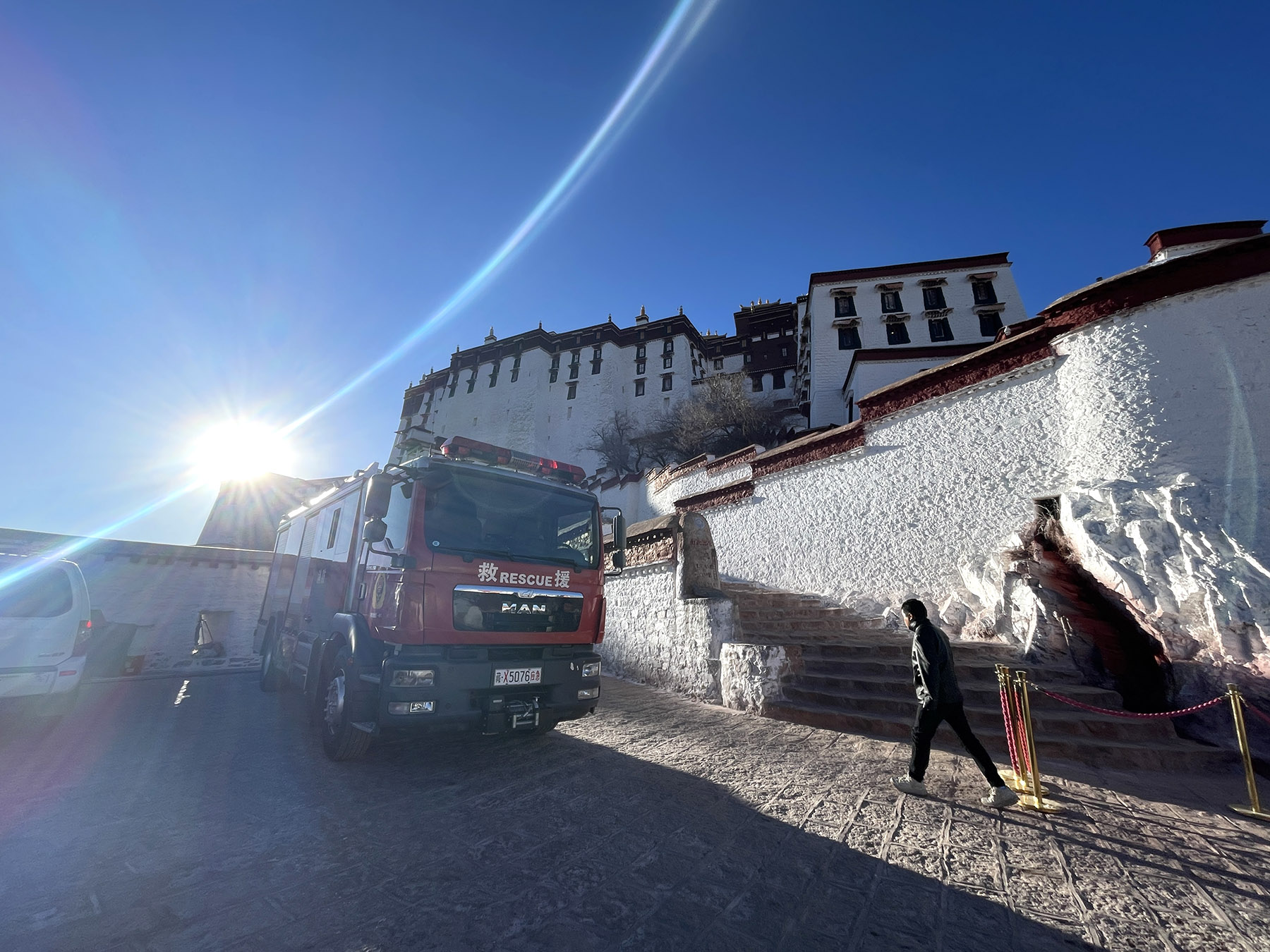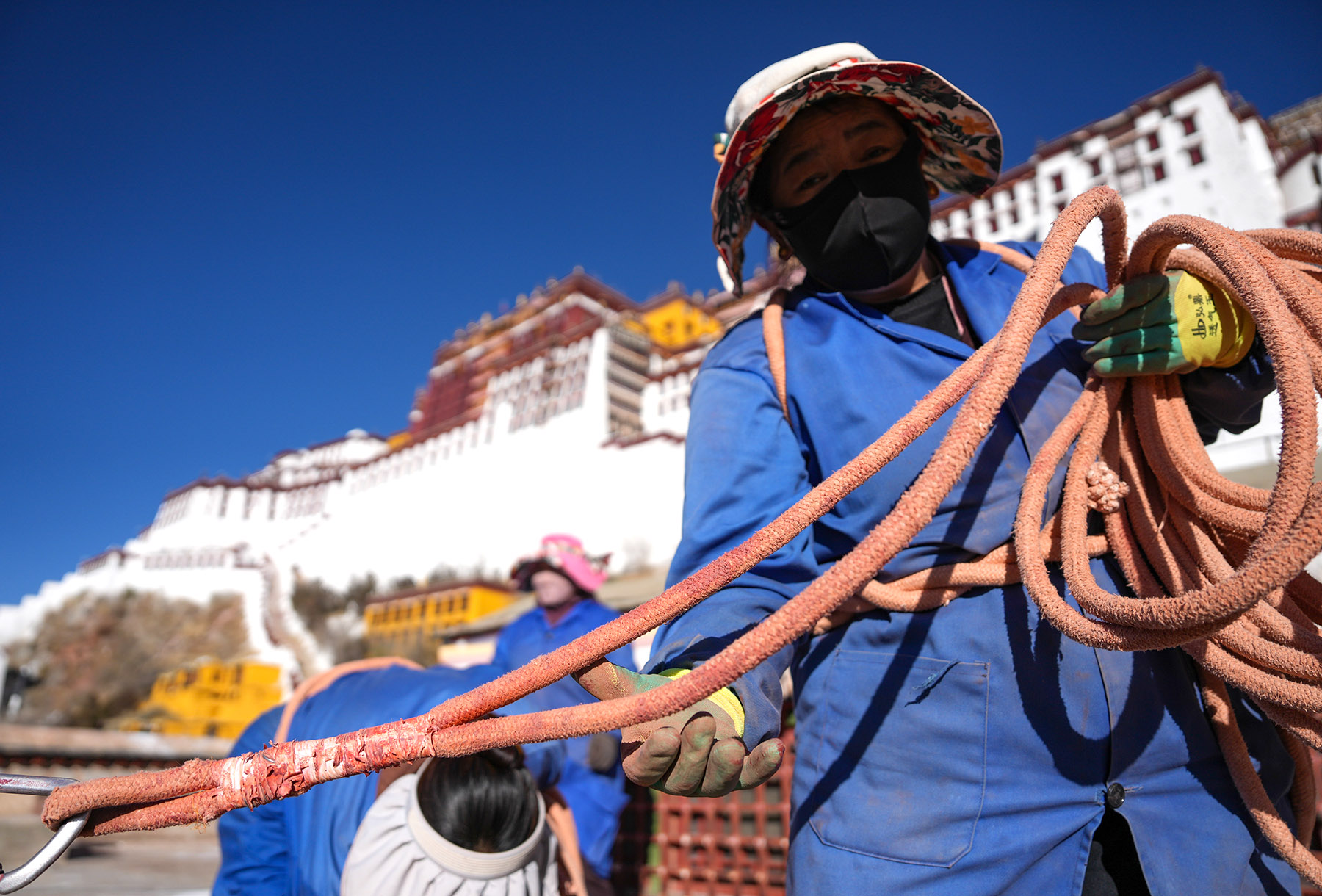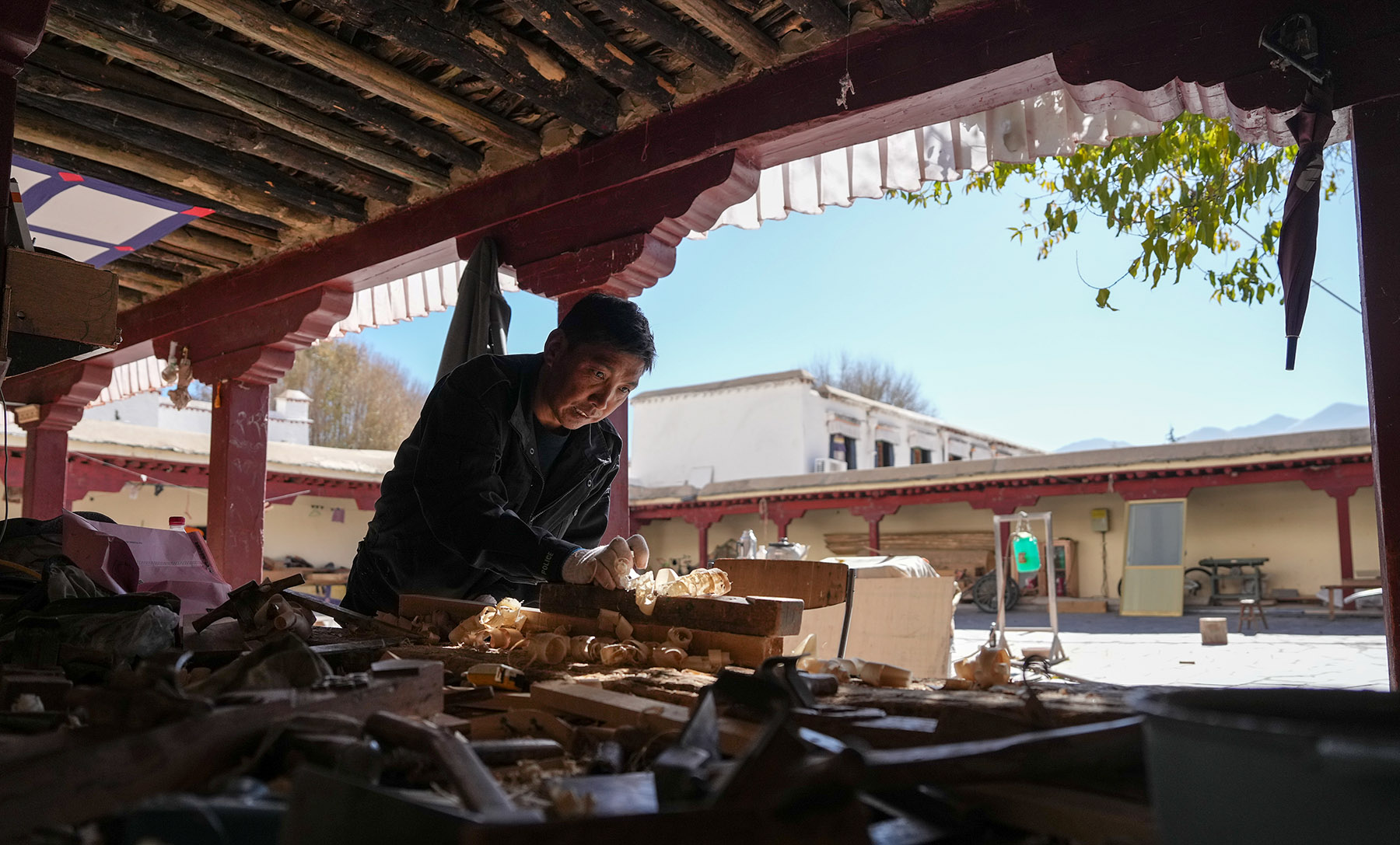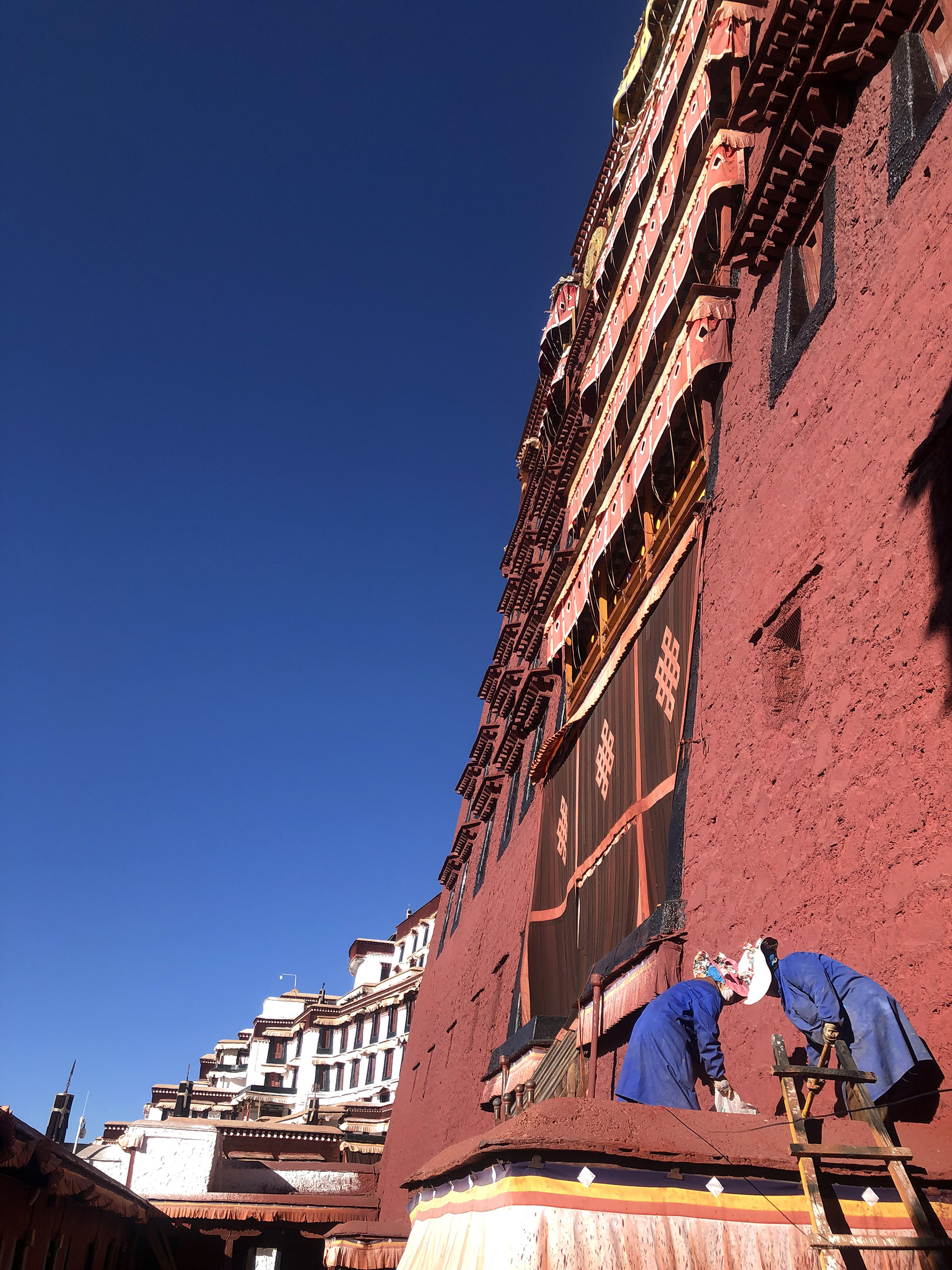Team of specialists and modern technology and equipment maintain the building's structural integrity and safety, Palden Nyima and Daqiong report in Lhasa.

Perched on crimson shoulders, Potala ascends a celestial stairway. Alabaster walls cradle golden roofs. Ancient stones murmur mantras, corridors breathe incense. Shadows dance with prayer flags, weaving time into silk. A sacred place in pilgrims' hearts, it guards the soul of this snowy plateau stretching vastly across western China.
As a UNESCO World Heritage Site, the Potala Palace in the heart of Lhasa, capital of the Xizang autonomous region, is one of the most iconic landmarks of the region, standing as a magnificent testament to Tibetan culture, ancient architecture and China's multicultural history.
Over the past decades, the Chinese government has invested heavily in the preservation of the Potala Palace, ensuring that this 1,300-year-old architectural marvel remains intact for future generations.
READ MORE: Palm-leaf scripture experts seek to master restoration
Through large-scale renovations, advanced technological monitoring and sustainable tourism management, the Potala Palace has been safeguarded against natural wear, structural risks and human impact.
First constructed in the 7th century by Tubo ruler Songtsen Gampo, the Potala Palace served as a royal palace and later a Buddhist administrative center. Much of its current structure dates back to the 17th century, following major expansion and reconstruction projects for the palace.
Kunga Tashi, deputy director of the Potala Palace Management Office, says that the entire construction history spans 13 centuries, and the architecture and cultural relics collected from various periods reflect the political, economic and cultural exchanges and integration among the various ethnic groups of China.
"Today, the palace complex covers 130,000 square meters, with its main building soaring 115.7 meters high, making it the largest and most complete palace-style complex in Xizang," says Kunga Tashi.
Palden Tsering, cultural and museum librarian at the Cultural Relics Research Office, of the Potala Palace Management Office, says the cultural relics of the Potala Palace include silk, various artifacts and silk clothing.
"The ancient documents that have been registered and compiled detail the Tripitaka (a collection of Buddhist teachings), and various classics related to the five major and five minor sciences of Tibetan culture.
"The thangka paintings show different art styles, including the schools of Chewo Gangba, Karma Gardri, Manthang, Chentse, and Nepal," says Palden Tsering.
The treasures of the palace also include various bowls and porcelain gifted by ancient emperors, Buddha statues preserved in the Lima Lhakhang Hall, the King Songtsen Gampo Cave, the Avalokitesvara Chapel and other areas throughout the temple.
"The Potala Palace has many varieties of rich, distinctive cultural relics, and it is a model of ancient Tibetan architectural features," Palden Tsering says, adding the palace has currently registered and documented over 100,000 cultural relics.

Devoting efforts
According to the palace's renovation department, the first large-scale repairs of the Potala Palace were made from 1989 to 1994, and they primarily addressed the structural risks of the palace.
The second phase of repairs took place between 2002 and 2009.
More than 200 million yuan ($28 million) was invested by the central government. The money mainly covered repairs of the palace's body and sleeper walls, restoration of its murals, and environmental improvements in its Shol Courtyard.
"In recent years, the palace has received a great deal of attention from the State relics protection experts with renovation work mainly involving seven golden roofs," says Dawa Ngodrub, an official of the renovation department, adding that in 2018, the outbuilding of the Shol Courtyard was renovated, costing more than 30 million yuan.
"We do a routine inspection of the Potala Palace every day, the job is the same year after year," he says.
Local government made numerous efforts and achieved wonderful results in repairing this ancient building. With many tourists visiting the palace every day, there are monitors to gauge the pressure of the footfall to protect the ancient structure from damage.
Lhundrub, another official from the Potala Palace Management Office, says they use a management model for tourist receptions that includes a reservation system, visitor flow control and staggered peak hours.
"The carrying capacity of the ancient building is limited. To better protect the Potala Palace, we have implemented a crowd-control management model," says Lhundrub, adding that tourists or pilgrims tend to concentrate in certain areas, and security personnel are equipped to divert crowds at any time based on monitoring videos and structural detection data.

Firefighting measures
Enriched with an abundant collection of historical relics, it is of utmost importance to prevent damage from disasters, as well as theft.
A fire rescue brigade has been stationed in the place since 2005, and the buildings of the palace are equipped with alarms, smoke detectors, temperature sensors and imaging.
The Potala Palace has 889 electrical circuits in a smart electrical system. The brigade has 36 firefighters — commanders and combatants.
Sonam Tenzin, a firefighter, says they have fire extinguishers appropriate for the ancient buildings, include knapsack type, trolley type and water-mist devices.
"They may use dry powder, water, carbon dioxide, chemicals or other suppressants," says Sonam Tenzin.
In addition to daily fire prevention work, they also lend helping hands to tourists.
"It's easy for tourists to get altitude sickness on the mountain. Their first thought is to seek the help of firefighters, which is another important task we perform," says Sonam Tenzin.

Apart from firefighters, monks and electricians also play important roles in palace protection.
Lobsang Chodrak, a caretaker of the monastic property, says the main responsibility of the monks is to protect and look after the external buildings and internal cultural relics of the Potala Palace.
"At the same time, we provide services to domestic and international tourists."
Once, there were places for boiling water and charging mobile phones, but not anymore, Lobsang Chodrak says.
"When monks leave home in the morning, they will cut off the power supply, and post a power outage symbol on the door when leaving after a power outage," he says.
Phuntsok Tsering, an electrician at the Potala Palace, says he needs to inspect each temple daily, and they check for abnormalities in each circuit section.
"Circuit risk is the biggest hidden fire danger. To prevent fires, we conduct daily inspections of each chapel one by one, and we walk 10,000 to 20,000 steps a day," he says.

Digital solutions
The Potala Palace Heritage Monitoring Center uses artificial intelligence, internet and big data to track structural stability, including monitoring wooden beams, walls and seismic activity. It also monitors environmental conditions, including humidity, temperature and pollutants.
Tenzin Kelsang, a staff member at the center, says the structural monitoring system has shifted the Potala Palace from passive repair after incidents to proactive prevention, where risks are discovered in advance.
ALSO READ: Lhasa's rich history fosters distinctive plateau culture
"The main function of the center is to provide necessary data for emergency reinforcement, repair projects, security technology and other major conservation projects, as well as to provide a decision-making basis for the protection of the palace's heritage," says Tenzin Kelsang.
Modern technology, the internet and big data have been utilized to establish a comprehensive management platform for the Potala Palace.
This platform plays a vital role in the daily management and scientific protection of the palace's ancient buildings and cultural relics.
Contact the writers at palden_nyima@chinadaily.com.cn


